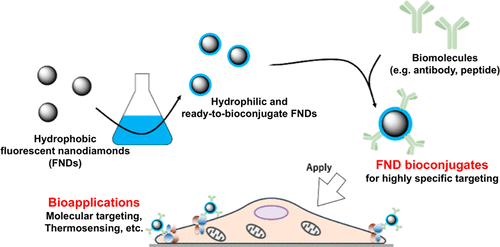当前位置:
X-MOL 学术
›
Bioconjugate Chem.
›
论文详情
Our official English website, www.x-mol.net, welcomes your
feedback! (Note: you will need to create a separate account there.)
One-Pot Synthesis of Highly Dispersible Fluorescent Nanodiamonds for Bioconjugation
Bioconjugate Chemistry ( IF 4.0 ) Pub Date : 2018-07-05 00:00:00 , DOI: 10.1021/acs.bioconjchem.8b00412 Daiki Terada 1 , Shingo Sotoma 2 , Yoshie Harada 2 , Ryuji Igarashi 1, 3, 4, 5 , Masahiro Shirakawa 1, 4
Bioconjugate Chemistry ( IF 4.0 ) Pub Date : 2018-07-05 00:00:00 , DOI: 10.1021/acs.bioconjchem.8b00412 Daiki Terada 1 , Shingo Sotoma 2 , Yoshie Harada 2 , Ryuji Igarashi 1, 3, 4, 5 , Masahiro Shirakawa 1, 4
Affiliation

|
Fluorescent nanodiamonds (FNDs) have been attracting much attention as promising therapeutic agents and probes for bioimaging and nanosensing. For their biological applications, several hydrophilizing methods to enhance FND colloidal stability have been developed to suppress their aggregation and the nonspecific adsorption to biomolecules in complex biomedical environments. However, these methods involve several complicated synthetic and purification steps, which prohibit the use of FNDs for bioapplications by biologists. In this study, we describe a simple one-pot FND hydrophilization method that comprises coating of the surface of the nanoparticles with COOH-terminated hyperbranched polyglycerol (HPG-COOH). HPG-COOH-coated FNDs (FND-HPG-COOHs) were found to exhibit excellent dispersibility under physiological conditions despite the thinness of the 5 nm HPG-COOH layer. Biotinylated FND-HPG-COOHs specifically captured avidin molecules in the absence of nonspecific protein adsorption. Moreover, we demonstrated that FND-HPG-COOHs conjugated with antibodies can be used to selectively target integrins in fixed HeLa cells. In addition, intracellular temperature changes were measured via optically detected magnetic resonance using FND-HPG-COOHs conjugated with mitochondrial localization signal peptides. Our one-pot synthetic method will encourage the broad use of FNDs among molecular and cellular biologists and pave the way for extensive biological and biomedical applications of FNDs.
中文翻译:

一锅合成高分散性荧光纳米金刚石用于生物缀合
荧光纳米金刚石(FND)作为有前途的生物成像和纳米传感治疗剂和探针已引起了广泛的关注。对于它们的生物学应用,已经开发了几种增强FND胶体稳定性的亲水化方法,以抑制它们的聚集以及在复杂的生物医学环境中对生物分子的非特异性吸附。但是,这些方法涉及几个复杂的合成和纯化步骤,这禁止生物学家将FND用于生物应用。在这项研究中,我们描述了一种简单的单锅FND亲水化方法,该方法包括用COOH封端的超支化聚甘油(HPG-COOH)涂覆纳米颗粒的表面。尽管5nm HPG-COOH层很薄,但发现在HPG-COOH涂层的FND(FND-HPG-COOHs)在生理条件下仍具有出色的分散性。在没有非特异性蛋白质吸附的情况下,生物素化的FND-HPG-COOHs特异性捕获了抗生物素蛋白分子。此外,我们证明与抗体结合的FND-HPG-COOHs可用于选择性靶向固定HeLa细胞中的整联蛋白。另外,使用与线粒体定位信号肽缀合的FND-HPG-COOH,通过光学检测的磁共振测量细胞内温度变化。我们的一锅合成方法将鼓励分子生物学和细胞生物学家广泛使用FND,并为FND的广泛生物和生物医学应用铺平道路。在没有非特异性蛋白质吸附的情况下,生物素化的FND-HPG-COOHs特异性捕获了抗生物素蛋白分子。此外,我们证明与抗体结合的FND-HPG-COOHs可用于选择性靶向固定HeLa细胞中的整联蛋白。另外,使用与线粒体定位信号肽缀合的FND-HPG-COOH,通过光学检测的磁共振测量细胞内温度变化。我们的一锅合成方法将鼓励分子生物学和细胞生物学家广泛使用FND,并为FND的广泛生物和生物医学应用铺平道路。在没有非特异性蛋白质吸附的情况下,生物素化的FND-HPG-COOHs特异性捕获了抗生物素蛋白分子。此外,我们证明与抗体结合的FND-HPG-COOHs可用于选择性靶向固定HeLa细胞中的整联蛋白。另外,使用与线粒体定位信号肽缀合的FND-HPG-COOH,通过光学检测的磁共振测量细胞内温度变化。我们的一锅合成方法将鼓励分子生物学和细胞生物学家广泛使用FND,并为FND的广泛生物和生物医学应用铺平道路。胞内温度变化是通过光学检测的磁共振测量的,该磁共振使用结合了线粒体定位信号肽的FND-HPG-COOHs进行。我们的一锅合成方法将鼓励分子生物学和细胞生物学家广泛使用FND,并为FND的广泛生物和生物医学应用铺平道路。胞内温度变化是通过光学检测的磁共振测量的,该磁共振使用结合了线粒体定位信号肽的FND-HPG-COOHs进行。我们的一锅合成方法将鼓励分子生物学和细胞生物学家广泛使用FND,并为FND的广泛生物和生物医学应用铺平道路。
更新日期:2018-07-05
中文翻译:

一锅合成高分散性荧光纳米金刚石用于生物缀合
荧光纳米金刚石(FND)作为有前途的生物成像和纳米传感治疗剂和探针已引起了广泛的关注。对于它们的生物学应用,已经开发了几种增强FND胶体稳定性的亲水化方法,以抑制它们的聚集以及在复杂的生物医学环境中对生物分子的非特异性吸附。但是,这些方法涉及几个复杂的合成和纯化步骤,这禁止生物学家将FND用于生物应用。在这项研究中,我们描述了一种简单的单锅FND亲水化方法,该方法包括用COOH封端的超支化聚甘油(HPG-COOH)涂覆纳米颗粒的表面。尽管5nm HPG-COOH层很薄,但发现在HPG-COOH涂层的FND(FND-HPG-COOHs)在生理条件下仍具有出色的分散性。在没有非特异性蛋白质吸附的情况下,生物素化的FND-HPG-COOHs特异性捕获了抗生物素蛋白分子。此外,我们证明与抗体结合的FND-HPG-COOHs可用于选择性靶向固定HeLa细胞中的整联蛋白。另外,使用与线粒体定位信号肽缀合的FND-HPG-COOH,通过光学检测的磁共振测量细胞内温度变化。我们的一锅合成方法将鼓励分子生物学和细胞生物学家广泛使用FND,并为FND的广泛生物和生物医学应用铺平道路。在没有非特异性蛋白质吸附的情况下,生物素化的FND-HPG-COOHs特异性捕获了抗生物素蛋白分子。此外,我们证明与抗体结合的FND-HPG-COOHs可用于选择性靶向固定HeLa细胞中的整联蛋白。另外,使用与线粒体定位信号肽缀合的FND-HPG-COOH,通过光学检测的磁共振测量细胞内温度变化。我们的一锅合成方法将鼓励分子生物学和细胞生物学家广泛使用FND,并为FND的广泛生物和生物医学应用铺平道路。在没有非特异性蛋白质吸附的情况下,生物素化的FND-HPG-COOHs特异性捕获了抗生物素蛋白分子。此外,我们证明与抗体结合的FND-HPG-COOHs可用于选择性靶向固定HeLa细胞中的整联蛋白。另外,使用与线粒体定位信号肽缀合的FND-HPG-COOH,通过光学检测的磁共振测量细胞内温度变化。我们的一锅合成方法将鼓励分子生物学和细胞生物学家广泛使用FND,并为FND的广泛生物和生物医学应用铺平道路。胞内温度变化是通过光学检测的磁共振测量的,该磁共振使用结合了线粒体定位信号肽的FND-HPG-COOHs进行。我们的一锅合成方法将鼓励分子生物学和细胞生物学家广泛使用FND,并为FND的广泛生物和生物医学应用铺平道路。胞内温度变化是通过光学检测的磁共振测量的,该磁共振使用结合了线粒体定位信号肽的FND-HPG-COOHs进行。我们的一锅合成方法将鼓励分子生物学和细胞生物学家广泛使用FND,并为FND的广泛生物和生物医学应用铺平道路。











































 京公网安备 11010802027423号
京公网安备 11010802027423号